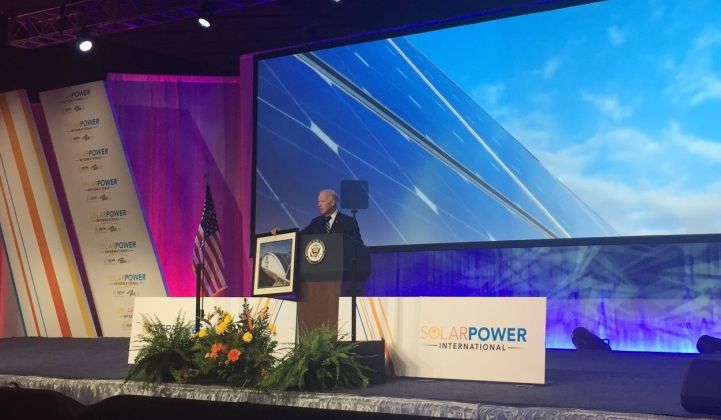Anyone standing in the way of solar market growth will be left standing on the wrong side of history, said Vice President Joe Biden in an impassioned speech on Wednesday at Solar Power International.
“We want to give every American a choice, an energy choice on what they want to use, no matter who they are or where they live,” said Biden. “This isn’t a government mandate; it’s the market working.”
As demand for solar has increased, “Some of the most deep-pocketed special interests that have lobbied for years for fossil fuels have announced, ‘Let’s stop it, let's take away consumer choice, let’s stifle the market,’” Biden said later. “Isn’t it amazing?”
Since President Obama took office, the number of homes with rooftop solar has grown from around 66,000 to 734,000. In the second quarter of 2015, the U.S. solar industry surpassed 20 gigawatts of total operational PV capacity, according to GTM Research and the Solar Energy Industries Association. And as deployments have increased, the number of solar jobs has grown while costs have dropped, falling by 50 percent since 2010.
“This is not because of us, but I hope we helped,” said Biden.
In 2009, the White House invested $90 billion in clean energy through the Recovery Act, a portion of which helped to expand tax credits for solar and wind. Earlier this year, the White House called for the permanent extension of these incentives as part of the president’s proposed budget.
President Obama also called for doubling renewable energy generation by 2020 under his Climate Action Plan, and has sent a strong market signal for renewable energy growth with the Clean Power Plan.
The administration built on these actions today with the announcement of $120 million in funding commitments to scale up the deployment of clean energy in 15 states across the country.
The commitment includes $102 million in competitive grants for solar from the Department of Energy. Of that amount, $52 million will support 22 new projects in partnership with private companies, nonprofit organizations, universities and national labs. More than half of this funding will go toward projects aimed at reducing the costs of concentrating solar power.
The DOE also announced $20 million to advance next-generation PV technology and improve existing PV module performance. The remaining $30 million of available funding in the DOE tranche will go toward the development of new solar tools, technologies, and services designed to reduce system costs, attract project investment, and streamline regulatory processes.
Taken together, these investments are aimed at driving down solar PV costs beyond the current SunShot goals and making solar energy fully cost-competitive with traditional energy sources by the end of the decade.
“It’s a simple idea to reduce the cost of solar by another 75 percent by 2020, cut red tape and get next-generation technologies to the market faster, provide technical assistance to cities and households that want to go solar, and create tens of thousands of solar jobs,” said Biden. “It’s working, you’re making it work, we’re already ahead of schedule.”
Rounding out the $120 million commitment, the DOE’s State Energy Program awarded $5 million to 11 states to advance innovative approaches for local clean-energy development, and the DOE selected five teams competing for $5 million in SunShot Prize awards. The Department of Agriculture also announced nine grants totaling nearly $8 million to promote the adoption of clean-energy technologies for residents in remote rural areas.
These developments come against a backdrop of uncertain solar policy at all levels of government.
The vice president waded into the value-of-solar debate, calling out utilities and the Koch brothers for backing campaigns to limit net metering in Wisconsin and elsewhere. He also criticized special-interest groups working to end federal tax credits.
Unless Congress extends the ITC, the incentive will fall from 30 percent to 10 percent for commercial solar and to zero for residential solar at the end of next year. A recent report by SEIA and GTM Research found the incentive step-down would cause solar installations to drop by 50 percent in 2017.
A separate study released by SEIA and Bloomberg New Energy Finance found that the ITC step-down would trigger the loss of 80,000 solar jobs. SEIA is aiming to have an extension to the ITC passed as part of an omnibus spending bill before the end of the year.
Biden proposed cutting the $5 billion in subsidies for the fossil-fuel industry and redirecting them toward extending renewable energy tax credits, which he said would quadruple solar energy by 2022 and still leave $2 billion that could help reduce the deficit.
“The idea that we don’t think renewables are critical to the future of this country and we won't do everything to grow this industry is absolutely absurd,” said Biden. “Our children and grandchildren will look back on this period and this debate and wonder, 'What were they thinking about?' I’m not joking. […] The stakes are too high for shortsighted politics and short-term policy decisions.”
“There are some winners and losers, and we have to take care of the hard-working losers who end up in industries that aren’t going to be used as much. I think that’s a moral obligation we have to them,” he added, referencing coal workers. “But that is not a reason to continue a policy that is so damaging to our environment.”



